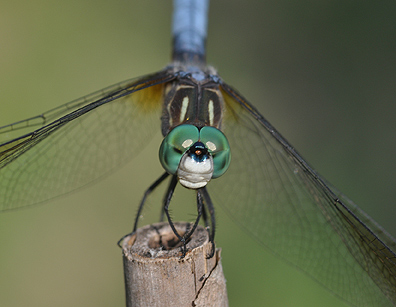Coleman's Bridge Road, Pemberton, NJ
Phone: (609) 259-2132
www.nj.gov/dep/fgw/wmas.htm
NJ Department of Environmental Protection
From the parking lot at North Branch Preserve, turn Right on Pemberton Bypass, and a quick left onto Coleman’s Bridge Road, which will become a dirt road. After 0.6 miles turn Right into the parking area for Pemberton Lake WMA. DIRECTIONS FROM NEAREST HIGHWAY: From Route 206 South at the intersection of Route 38 in Southampton Township, go Left on Route 38, which becomes County Route 530/ S. Pemberton Rd. After 2.7 miles, at the second of two closely-spaced traffic lights, bear Right on Magnolia Road. After 1.35 miles turn Left on Coleman?s Bridge Road, a dirt road, just past the lake. Proceed 0.1 miles to a large gravel parking area on the Left. Map
 |
| Blue Dasher | Will Kerling |
| |
| | A former cranberry bog, this 45- acre lake is now a popular site for fishing, as trout, bass, pickerel, perch, and sunfish are found in the lake’s crystal clear waters.
Narrow fishermans’ trails through the woods at the North end of the lake give visitors various vantage points from which to scan for waterfowl, wading birds, turtles, and unique wetlands plants along the lakeshore. Coleman’s Bridge Road makes an easy transect of the lowland forest, where songbirds are abundant and vocal through spring and summer, and maple, black gum, and sweet gum trees turn brilliant colors in the fall.
There are several small, shallow, sand-bottomed pools and ponds along the North shore of the lake where several species of dragonfly can be found. These include Eastern pondhawk, lancet clubtail, blue dasher, slaty skimmer, widow skimmer, black saddlebags, meadowhawk, common whitetail, green darner, Eastern amberwing and others.
When the lake is not frozen, Canada Geese, Mallards, Ring-necked Ducks, and Tundra Swans may be present. Scan the tree line for the occasional Red-tailed Hawk or Belted Kingfisher. If there is open water, look for Canada Geese, Mallards, and occasional Tundra
Swans on the pond.
Some winter waterfowl are more likely to be seen here in early spring, including Common Merganser, Ring-necked Duck, Green-winged Teal and Northern Pintail. Neotropical migrants arrive in April and May.
Resident birds include Green Heron, Blue-gray Gnatcatcher, Yellow-billed Cuckoo, Scarlet Tanager, Pine Warbler, and Ovenbird in addition to more common species. Dragonflies are abundant. Look for basking red-bellied and painted turtles, and Northern water snake along the shoreline.
to the presence of water and varied habitats, this is a great spot from which to experience fall bird migration. Autumn foliage colors peak in late October.
A few Pine Barrens lakeshore plant species are locally abundant, such as the spatulate-leaved sundew, redroot, Virginia meadow-beauty, yellow-eyed grass, cranberry and marsh Saint John’s-wort.
|